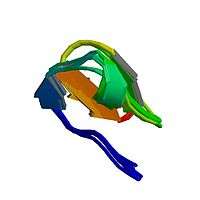Heteroscodratoxin-1
| Heteroscodratoxin-1 | |
|---|---|
|
Schematic diagram of the three-dimensional of Heteroscodratoxin-1.jpg. | |
| Identifiers | |
| Organism | |
| Symbol | N/A |
Heteroscodratoxin-1 (also known as kappa-theraphototoxin Hm1a or HmTx1) is a neurotoxin produced by the venom glands of Heteroscodra maculata (Togo starburst tarantula) [1] that shifts the activation threshold of voltage-gated potassium channels to more positive potentials.[2]
Sources
Heteroscodratoxin-1 can be obtained from venom glands of Heteroscodra maculata (Togo starburst tarantula or Togo starburst baboon spider).[2]
Chemistry
Heteroscodratoxin-1 is a basic protein (isoelectric point of 7.7) composed of 35 amino acids with a carboxylated C-terminus. Its sequence shows strong similarity with other taruntala toxins such as Scodratoxin, Hanatoxin and SGTx1. Structurally the protein belongs to the huwentoxin-1 family of inhibitory spider peptides based on its knottin backbone that consists of three crossing disulfide bridges (Cys1-Cys4/Cys2-Cys5/Cys3-Cys6).[2]
Target
Heteroscodratoxin-1 inhibits subtypes of both delayed rectifier (KV2.1 and KV2.2) and A-type rapidly inactivating (KV4.1, KV4.2 and KV4.3) voltage-gated potassium channels. At a concentration of 100-300 nM, in transfected COS cells it blocks 23% of KV2.1, 19% of KV2.2, 50% of KV4.1, 39% of KV4.2, and 43% of KV4.3 conductance at a potential of 0 mV. No significant effect on other A-type rapidly inactivating (KV1.4 and KV3.4) or delayed rectifier potassium channels (KV1.1, KV1.2, KV1.3, KV1.5, KV1.6, KV1.2/ KV1.5, or KVLQT1), or on sodium and calcium channels has been observed.[2]
Mode of action
It is thought that heteroscodratoxin-1 modifies gating of specific potassium channels by shifting the activation threshold to more positive values. As a result larger depolarizations are needed to open channels. The mechanism underlying this modification has been largely elucidated using molecular docking simulation for the KV2.1 potassium channel which is highly expressed in mammalian neurons and interacts strongly with heteroscodratoxin-1. In this model the C-terminal residue of the KV2.1 S3-segment (S3C) serves as a binding site for Hmtx-1 forming both hydrophobic and hydrophilic bonds. Interaction between the toxin and the potassium channel induces a helical movement of S3C resulting in limited spatial freedom of the S4-segment which is responsible for channel gating.[3]
Toxicity
Information on toxic effects of Heteroscodratoxin-1 in humans is not available. In mice, however, it has been found that intracerebroventricular injection of 500 pmol HmTx1 induces convulsions, spasms, tremors and death within 1 hour. At 100 pmol, a less severe response develops, although death still occurs after 2 hours.[2]
References
- "Kappa-theraphotoxin-Hm1a - Heteroscodra maculata (Togo starburst tarantula)". Uniprot.org. 2011-09-21. Retrieved 2011-10-08.
- Escoubas, Pierre (2002). "Novel tarantula toxins for subtypes of voltage-dependent potassium channels in the Kv2 and Kv4 subfamilies". Molecular Pharmacology.
- Shiau, Yu-Shuan (2003). "Structural Basis of Binding and Inhibition of Novel Tarantula Toxins in Mammalian Voltage-Dependent Potassium Channels". Chemical research in toxicology. 16 (10): 1217–25. doi:10.1021/tx0341097. PMID 14565763.
External links
- Heteroscodratoxin-1 from the Uniprot website
- Toxin card for Heteroscodratoxin-1 from the Toxin, Toxin-target database website
